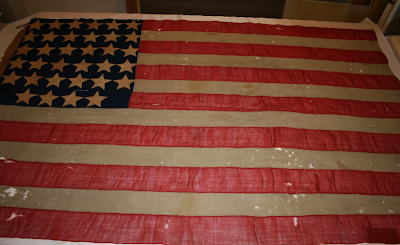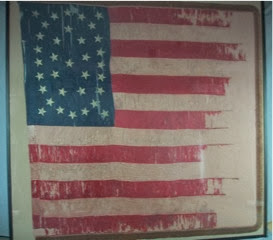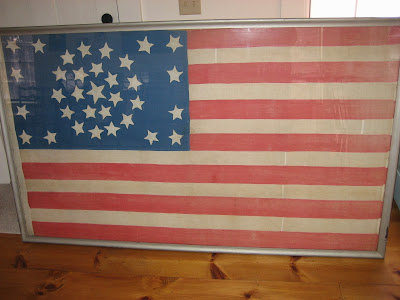Maybe we've mentioned in a few of our posts, we treat a lot of flags. And for us here at Spicer Art Conservation, LLC perhaps we think of it as common place that everyone else knows details of flag composition, types of flags, flag history, and what we like to think of as "flag trivia". Not surprising, those details, as well as lots of flag trivia, are not known by many, save perhaps some of our friends at NAVA, aka the North American Vexillological Association. We thought it would be fun to share some interesting flag facts and hope that maybe our blog readers will discover something they had not known before.
The first interesting flag fact that might not be known is that when some states became states, the number of stars on the flag did not increase automatically. For example, the 13-star flag was the official flag when Vermont (the 14th state) and Kentucky (state #15) were both admitted to statehood. Yet the 15 star flag did not become the new flag until nearly 3 years after Kentucky became a state.
This little tidbit of knowledge is handy when we talk about flags from the War of 1812. And with the 200th anniversary of the War of 1812 upon us, we have received several calls and emails with photographs of flags that were thought to be War of 1812 flags. A flag from the War of 1812 will be a 15-star AND 15-stripe flag, even though before the war even began in 1812, the United States consisted of 18 states; #16 Tennessee, #17 Ohio and #18 Louisiana. The most famous 15-star/15-stripe flag is the "Star Spangled Banner". 1818 marks the year of he next flag act. It is here that the stripes are returned to 13 to represent the original colonies and it is suggested that a new star be added for each of he new states on July 4th following their admittance to statehood, we've been doing this ever since.
 |
| This is the 15-star flag from Fort Niagara. It is a "Garrison" flag, meaning it is made to be so large that it will be easily seen by the enemy when flown from a fort or garrison. |
Which numbered star flag existed for the shortest amount of time? Hmmm...this is a tricky bit of trivia because of the official status of flags as described above. So even though a state had officially become a state, it was a flag act that created a new flag with accurate star count. And this only happened on July 4th. But that said, certainly it did not stop the good citizens of those states from making their own unofficial flags with the number of stars sewn upon it to represent their new statehood. Great examples of this and the answer to which amount of stars existed for the shortest amount of time is the 10 day jump from 38 to 42-stars (these are unofficial flags of course). North and South Dakota are made states on the same day on November 2, 1889. North Dakota is first (the 39th) so technically a 39-star flag exists for the shortest duration, but that is not to say it is the rarest. However, South Dakota (#40) is followed 6 days later by Montana (#41) and two days after that, Washington becomes #42. Washington stood as the final state for about 8 months and just as soon as people were comfortable stitching a 42-star flag, Idaho became #43 the day before the next official flag resolution was passed on July 4, 1890. Officially however, the answer is that the 20, 21, 25, 27-29, 32, 43 and 49-star flags were only official for one year each.
Interesting for us from the conservation point of view is that an early Revolutionary War era flag might appear in as good, if not better, condition than a flag constructed 100 years later. See the flags below, each is a 34-star flag, constructed in the same time, yet the conditions are quite different. This of course is due in part to the materials it is composed of, how it was stored, what it was exposed to and how much time it spent exposed to those conditions (excessive light, weather, water, etc)
 |
| This 34-star flag was improperly stored and suffered a tremendous amount of mold damage. 34-stars flags were official from July 4, 1861 (Kansas #34) to July 4, 1863 when West Virginia became # 35. |
 |
| This 34-star flag suffered insect damage. |
 |
| A 34-star flag with yet another creative star pattern. This flag was in the most deteriorated condition of the three 34-star flags we are showing here. |
 |
| This 33-star flag is in remarkable condition, having been stored properly and cared for continuously. |
Another interesting fact is that our current 50-stars is the longest continuous design in our history. This past July 4th marked the 53rd year of its use.
We are often asked which is the rarest flag that has ever been treated at Spicer Art Conservation. This is a tough question to answer as some flags are historically important, while others are one-of-a-kind, some are incredibly old, and some are privately owned and belong to extraordinary and remarkable collections. Rare, I suppose, is in the eye of the beholder. What I do know is that each flag that enters the studio is unique and often is accompanied by a great story which often teaches us something, adding to our own flag trivia.
To see more flags treated by Spicer Art Conservation go to our website. If flags make you think of Betsey Ross, find some flags and trivia in another recent blog post here.
_____________________________
Gwen Spicer is a textile conservator in private practice. Spicer Art Conservation specializes in textile conservation, object conservation, and the conservation of works on paper. Gwen's innovative treatment and mounting of flags and textiles is unrivaled. To contact her, please visit her website.
To see more flags treated by Spicer Art Conservation go to our website. If flags make you think of Betsey Ross, find some flags and trivia in another recent blog post here.
_____________________________
Gwen Spicer is a textile conservator in private practice. Spicer Art Conservation specializes in textile conservation, object conservation, and the conservation of works on paper. Gwen's innovative treatment and mounting of flags and textiles is unrivaled. To contact her, please visit her website.

No comments:
Post a Comment